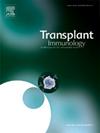Syngeneic hematopoietic stem cell transplantation from an identical twin sister in an AML patient: “A case report highlighting accelerated engraftment and reduced transfusion requirements”
IF 1.4
4区 医学
Q4 IMMUNOLOGY
引用次数: 0
Abstract
Background and objective
Hematopoietic stem cell transplantation (HSCT) is among the most effective immunotherapeutic strategies for treating hematologic malignancies in both pediatric and adult patients. Its global use has been steadily increasing. Patients undergoing HSCT commonly require transfusion support with blood products until engraftment is achieved, and transfusion requirements can significantly affect post-transplant outcomes. Despite advancements that have improved survival rates, transplant-related mortality (TRM) continues to be a major obstacle to optimal outcomes.
Case presentation
We present the case of a 46-year-old woman diagnosed with acute myeloid leukemia (AML) harboring an FLT3-ITD mutation, who underwent allogeneic HSCT. The donor was her identical twin sister, with full HLA compatibility (a 10/10 match) and an identical ABO blood group (O positive). Notably, the patient exhibited rapid neutrophil and platelet engraftment by day +9, which is earlier than typically observed in transplants from fully matched related or unrelated donors. Furthermore, the patient did not require any red blood cell or platelet transfusions during the transplantation period and developed no signs of acute or chronic graft-versus-host disease (GVHD). She has remained disease-free with no evidence of relapse for over three years post-transplant.
Conclusion
HSCT from an identical twin donor may provide favorable clinical outcomes, including accelerated engraftment and reduced transfusion needs during the transplantation process.
来自同卵双胞胎姐妹的同基因造血干细胞移植在AML患者中的应用:“一个强调加速移植和减少输血需求的病例报告”
背景和目的造血干细胞移植(HSCT)是治疗儿童和成人恶性血液病最有效的免疫治疗策略之一。它的全球使用量一直在稳步增长。接受造血干细胞移植的患者通常需要输血支持,直到移植完成,输血需求会显著影响移植后的结果。尽管进步提高了生存率,但移植相关死亡率(TRM)仍然是实现最佳结果的主要障碍。病例介绍:我们报告一名46岁的女性,被诊断为急性髓性白血病(AML),携带FLT3-ITD突变,她接受了同种异体造血干细胞移植。供体是她的同卵双胞胎姐妹,HLA完全兼容(10/10匹配),ABO血型相同(O阳性)。值得注意的是,患者在第9天表现出快速的中性粒细胞和血小板植入,这比完全匹配的亲属或非亲属供体移植通常观察到的要早。此外,患者在移植期间不需要任何红细胞或血小板输注,也没有出现急性或慢性移植物抗宿主病(GVHD)的迹象。她在移植后三年多的时间里没有复发的迹象。结论来自同卵双胞胎供体的hsct可能提供良好的临床结果,包括在移植过程中加速植入和减少输血需求。
本文章由计算机程序翻译,如有差异,请以英文原文为准。
求助全文
约1分钟内获得全文
求助全文
来源期刊

Transplant immunology
医学-免疫学
CiteScore
2.10
自引率
13.30%
发文量
198
审稿时长
48 days
期刊介绍:
Transplant Immunology will publish up-to-date information on all aspects of the broad field it encompasses. The journal will be directed at (basic) scientists, tissue typers, transplant physicians and surgeons, and research and data on all immunological aspects of organ-, tissue- and (haematopoietic) stem cell transplantation are of potential interest to the readers of Transplant Immunology. Original papers, Review articles and Hypotheses will be considered for publication and submitted manuscripts will be rapidly peer-reviewed and published. They will be judged on the basis of scientific merit, originality, timeliness and quality.
 求助内容:
求助内容: 应助结果提醒方式:
应助结果提醒方式:


